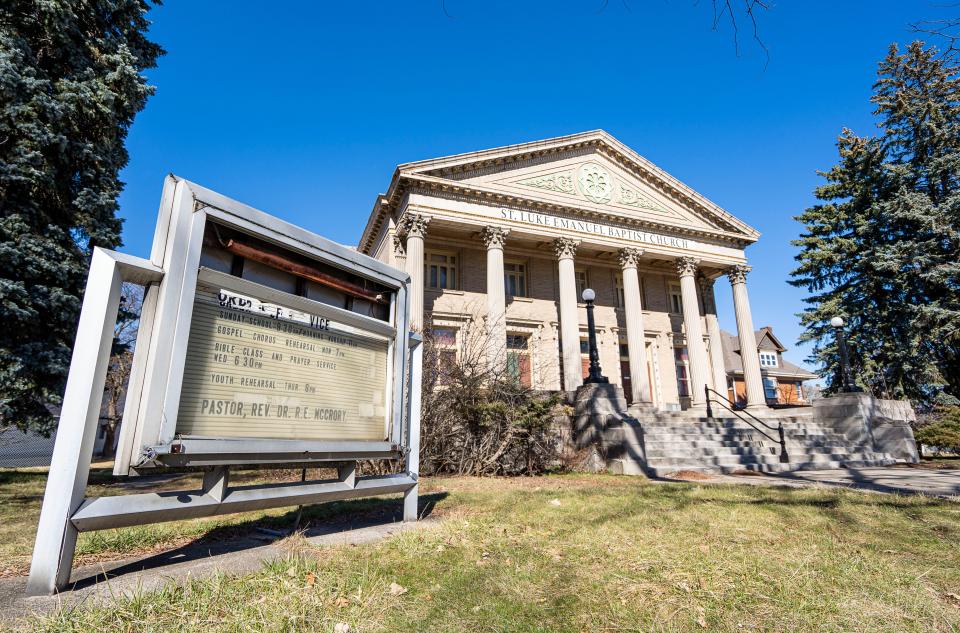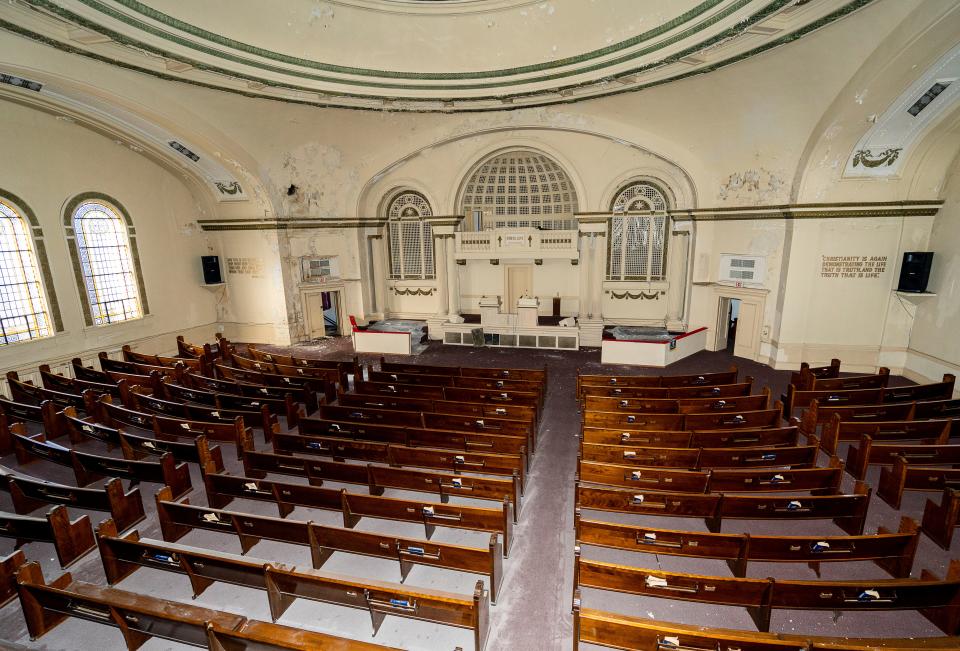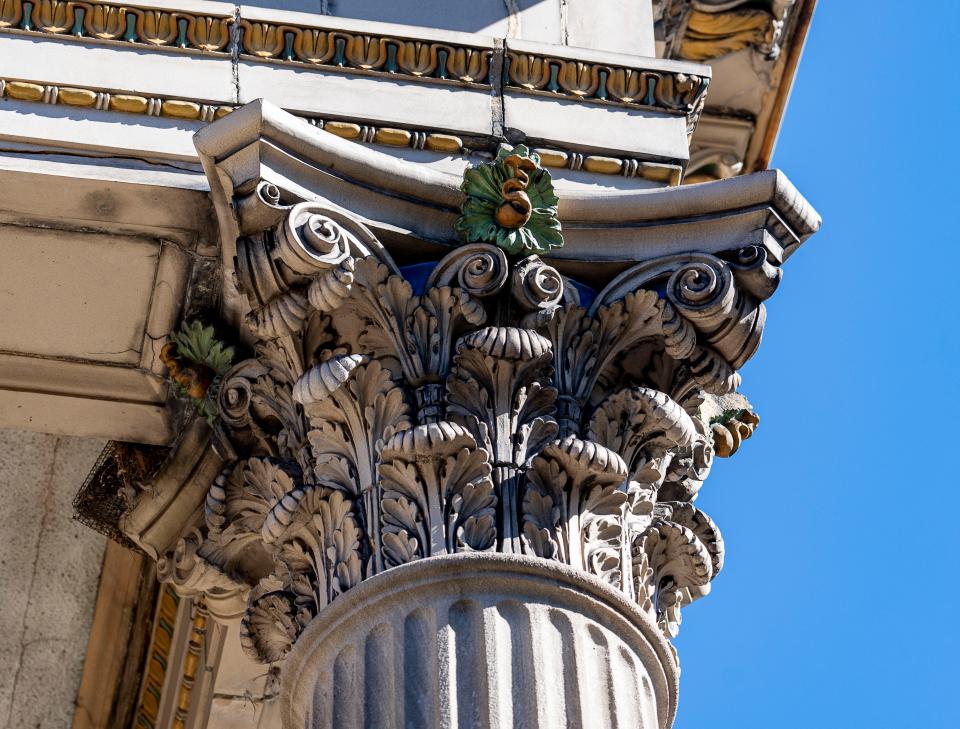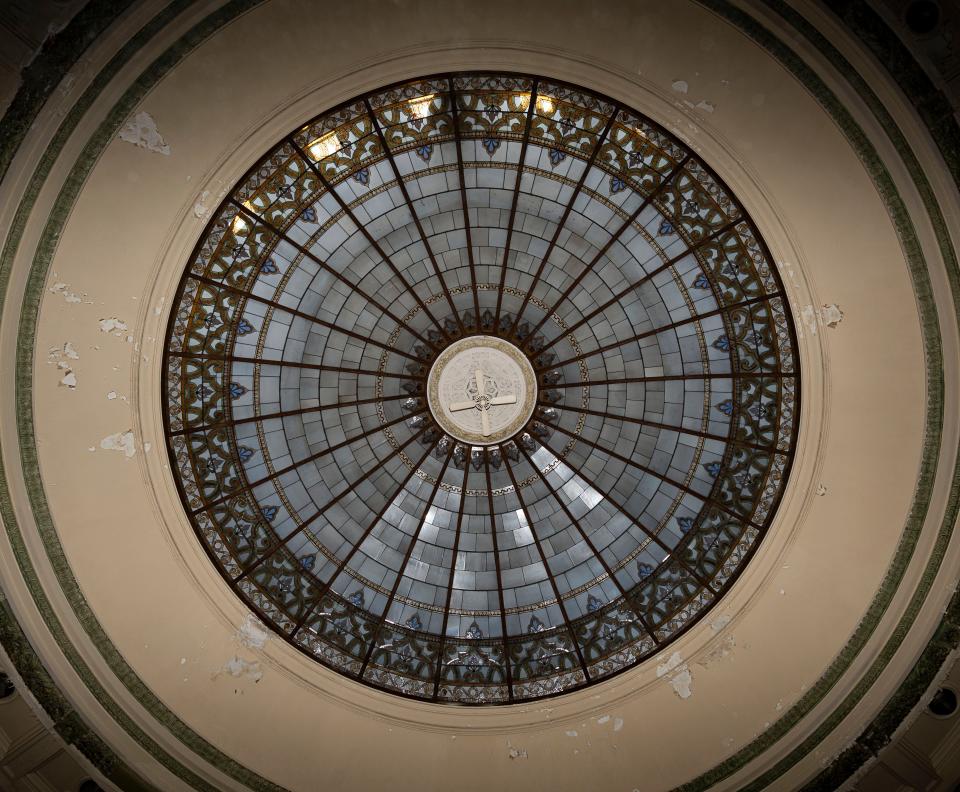From Christian Scientists to Baptists to Pentecostals, historic Milwaukee church begins a new chapter
As the pastor first stepped inside the cavernous Milwaukee church modeled after the Roman Pantheon, he took a moment to take in the space.
“Lord,” the Rev. Francisco García Colón recalled thinking to himself, “I never asked you for something so big.”
García Colón leads a small but growing Spanish-speaking Pentecostal congregation, which bought the church at 2722 W. Highland Blvd., earlier this month.
The congregation hopes to breathe new life into the 22,000-square foot building, most recently known as St. Luke Emanuel Missionary Baptist Church. It's one the last neoclassical churches still standing in Milwaukee, and its imposing design landed it a spot on the National Register of Historic Places.
It's a big step up for the congregation, which got its start in 2017 with a couple of dozen people worshiping in a home basement. They will be the third congregation to call the church home.
For most of its 110 years, the building itself was largely untouched. That changed in the last year, when it sat vacant and trespassers ran roughshod over it.
In 1914, the church cost its original congregation $135,000 to build — equivalent to more than $4 million today. García Colón's congregation bought it for $10,000 less this year — $125,000 in cash.
The property's recent history offers a glimpse at trends that could shape the city's future — from the hard questions declining churches face over their properties, to the impact of out-of-state investors on Milwaukee neighborhoods, to the immigrant communities who hold a key to the city's population growth and revitalization.

Under stained-glass dome, peeling plaster and debris
The church's most impressive features remain.
Past Corinthian columns at the entrance, the main auditorium features rows of pews arranged in concentric arcs around a grand pulpit on a whitewashed north wall. Overhead is a dome with leaded glass.
But shortly before the sale closed, the arched walls had a shredded look from peeling plaster which was falling into aluminum pans on the floor. A pew was covered in shattered glass. One stairwell was so damaged from falling ceiling pieces that it was impassable. Bathroom toilets and sinks were smashed.
An Instagram handle was spelled out in the dust of a pew. On that Instagram account, pictures from inside the vacant church were posted, captioned with the hashtag “gotrespassing.”
Nathan White, an investor who lives in the suburbs of Fort Worth, didn't anticipate what would happen when he bought the building last year for $200,000, according to his Realtor, Jennifer Hupke.
White didn't respond to Journal Sentinel calls and emails.
Hupke said White is a devout Christian, and had plans to restore the Highland Boulevard church but never ended up visiting in person. The same month he bought the church in Milwaukee, he bought two other churches in different parts of the country, Hupke said.
"I think his faith is such that he feels he can improve anything that he touches. And sometimes that’s not always realistic," she said.
While it sat empty, thieves stripped the property for radiators and copper pipes, Hupke said. The basement had flooded and then frozen so much from radiator lines that it looked like an ice rink, she said. At one point last year, a homeless encampment had set up on the church playground, she said.
White began racking up expensive fees from the city of Milwaukee, Hupke said. She feels White was unfairly targeted by city inspectors as an out-of-state owner who bought the property through an LLC.
Hupke said the city shares some blame for allowing crime and poverty to fester in the area. Many neighboring properties are vacant, too, which attracts trespassers and crime to the area — something White didn’t realize when he bought the building, she said.
"He didn't have an understanding of location. He saw a big beautiful building online," she said.

Christian Scientists moved in during neighborhood's boom years
In 1914, when Christian Scientists held the first service in the building, the neighborhood was booming.
Expanded streetcar access made the west end of Milwaukee ripe for development. The area was home to many well-to-do German immigrants, earning Highland Boulevard the nickname “Sauerkraut Boulevard.”
At the time, the Church of Christ, Scientist was booming too.
Milwaukee was an early outpost for the religious group, which was founded outside of Boston by a woman who believed she could heal herself and others through prayer.
A Milwaukee dentist and his wife returned to Milwaukee, after studying Christian Science healing methods in Massachusetts, and in 1884, the State of Wisconsin granted them a charter to open the Wisconsin Metaphysical Institute.
Christian Science amassed a large following in Milwaukee, and its congregations built churches across the city.
In 1913 a Christian Science congregation bought the lot on Highland Boulevard and North 27th Street, and enlisted renowned Milwaukee architect Carl Barkhausen to design a church. In June 1914, the Second Church of Christ, Scientist opened.
The Pantheonic church was large enough to seat about 1,400 people, but by 1917, it was already too small for the fast-growing Christian Science community. Three additional congregations splintered off from Highland Boulevard.

Church, neighborhood both undergo rapid change
Once the fastest-growing religion in the United States, Christian Science waned in popularity after World War II. Improvements in medical science dampened enthusiasm for spiritual healing, scholars say.
The neighborhood surrounding Second Church of Christ, Scientist, changed, too. Many large mansions along Highland had been subdivided into rooming houses during World War II. In the 1960s, many more were razed to make way for apartment buildings.
Many of the affluent German residents of “Sauerkraut Boulevard” had scattered, moving to the surrounding suburbs.
Across the city, Milwaukee’s Christian Scientists struggled to maintain the massive buildings they built at the turn of the century.
In November 1985, the Highland Boulevard church sold to a Baptist congregation. The structure was renamed St. Luke Emanuel Missionary Baptist Church.
“Mostly it’s the economic crunch,” a Christian Science spokesman told The Milwaukee Journal at the time, adding, “They want to devote more of their time and resources to things other than the upkeep of buildings.”

New life inside the church after Baptist congregation moves in
By summer 1991, as Rev. Jesse Jackson took to the pulpit, the church once again overflowed.
“I remember it was just packed wall to wall,” said Evelyn McCrory, whose husband, the Rev. Ron McCrory, later became pastor of St. Luke, succeeding his father, the Rev. Robert McCrory.
Jackson came to Milwaukee to speak out on behalf of Jeffrey Dahmer’s victims, whose remains had been discovered a few weeks earlier just blocks away.
Those victims were made vulnerable by disinvestment in Milwaukee’s central city, Jackson said during his visit.
The crowd at St. Luke’s that day was predominantly Black, as was the neighborhood. Outside, Jackson helped register people to vote, according to the Milwaukee Sentinel.
Most days, Evelyn McCrory said, the church was much quieter — even in the early years, when about 300 members belonged to the St. Luke’s Emanuel congregation.
“It was a huge building, and we never used all that space,” she said.
Still, the spacious church served the congregation well and helped bring the community together at critical moments — with memorial services not just for Dahmer's victims, but also for Milwaukee Police Officer Wendolyn Odell Tanner, who was shot in the line of duty.
The McCrorys took pride in the building, and the congregation hosted events for the public, spotlighting the church’s history.
Building maintenance was 'one thing after another after another'
Over the years, however, the aging building became too much to maintain — it was just “one thing after another after another,” Evelyn McCrory said.
Quotes for replacing the roof alone were as high as $220,000, she said. The copper, domed roof — a distinctive, Pantheonic feature — was leaking, after being patched over a couple of times.
Despite applying for historic preservation grants, the congregation couldn’t afford all the repairs the building needed.
Over the years, the St. Luke’s congregation shrank significantly.
During the pandemic, Rev. Ron McCrory began broadcasting services from home, over Facebook Live. Since then, it’s been hard to bring people back together in person, Evelyn said.
In 2023, the congregation made the difficult decision to sell. It was “heart-wrenching,” Evelyn said.
Today, the congregation is looking to lease new worship space. Though the McCrorys would like to buy another church eventually, for now they’re focused just on bringing the congregation back together.
The McCrorys still drive down Highland Boulevard every now and then, so they had seen the church’s boarded-up doors. At one point last year, the pastor from another church on Highland Boulevard called them.
“He had seen some suspicious activity and wanted to know if everything was OK,” Evelyn said. “And we had to inform him, well — we had sold the building.”
Learning about the trespassing and damage of the past year left the McCrorys frustrated, considering their efforts to secure funding and keep the building in shape.
Many things have changed since his father bought the church, Rev. Ron McCrory said. The surrounding community is struggling with homelessness and crime, he said, and many young people are searching for meaning outside of the church.
“It’s a different world now,” he said.
Damage to the vacant church is a 'cautionary tale'
What happened in the last year at the Highland Boulevard church should be a “cautionary tale,” said Mark Elsdon, a Madison-based expert on the future of church properties.
Elsdon is the editor of the book, "Gone for Good? Negotiating the Coming Wave of Church Property Transition?" He cites research that as many as one-third of church properties nationally could close or change purpose in the next decade.
Church leaders — and cities — are often unprepared to handle those closures and ensure the buildings continue to serve their communities after the congregation leaves.
“It is very possible for investors, or whomever, to just buy them and sit on them and do nothing,” Elsdon said. “Rarely is that a good outcome for a neighborhood for a church to sit empty.”
Churches are often more than just a worship space, Elsdon notes. They may host neighborhood association meetings, Alcoholics Anonymous groups, Girl Scout troops, polling sites and food pantries.
“When a church gets boarded up,” he said, “that’s all gone.”
Elsdon said the problem is bigger than many realize, and that congregations and cities can do more to plan for repurposing churches before it’s too late. A church liaison in the city planning division, for instance, could help pastors looking to sell their buildings with zoning questions, redevelopment funding and more, he said.
“If it’s one or two churches (that close), that’s fine. But if it’s a third of them, then you’ve got a lot going on,” he said. “That’s going to have a huge impact on neighborhoods all over the place. Then it’s worth investing some energy there.”
Latino congregation growing from near south side roots
In many ways, García Colón's congregation is a natural heir to the Highland Boulevard church, whose owners have reflected the changing makeup of the city.
Over more than a century, the church traded hands from Christian Scientists who descended from European immigrants; to Baptists who confronted racial inequality head-on; to Pentecostals who hail from Milwaukee's fast-growing Latino immigrant community on the south side.
García Colón feels confident that his congregation, Iglesia Pentecostés Manada Pequeña, can rise to the occasion. The congregation of about 70 to 80 people is growing fast. It outgrew a basement, then a south side Milwaukee storefront, then a second storefront, all in seven years.
Still, the church presents an enormous undertaking, likely one of the largest houses of worship for Latino evangelicals in Milwaukee.
As churches shutter because of declining, aging membership in other denominations, Latino evangelical congregations are booming. Younger on average than the U.S. population, they are the fastest-growing group of evangelicals and are reshaping the faith.
García Colón and his wife, Yarizel López, are from Puerto Rico. Church members hail from Puerto Rico, Mexico, Nicaragua and the Dominican Republic. The pastor is not daunted by the extensive work needed on the Highland Boulevard church — or the costs — and expects he and the members will do most of the renovations, working “day, evening and night.”
That will include drywall and plaster work, painting, plumbing and eventually building a parking lot.
"The Bible says that he (God) will supply everything that we need," said García Colón in Spanish, as interpreted by church member Nolvia Mejia. "There’s been times where I myself say, 'Hmm, where are we going to get these funds from?' And then suddenly people show up and start donating."
When he saw the listing for the Highland Boulevard church, García Colón jumped at the chance to buy it. It was only an 11-minute drive from the current storefront church and fits his vision for a bigger, better future for the congregation.
García Colón has an unshakeable faith that the move, indeed the fate of the congregation, is in God's hands and will not fail.
“If in almost seven years, he has not left us, I don’t think he’s going to leave us now,” he said.
More: How do you sell a church? Just ask this Realtor.
This article originally appeared on Milwaukee Journal Sentinel: Pentecostal congregation buys historic Milwaukee Baptist church

